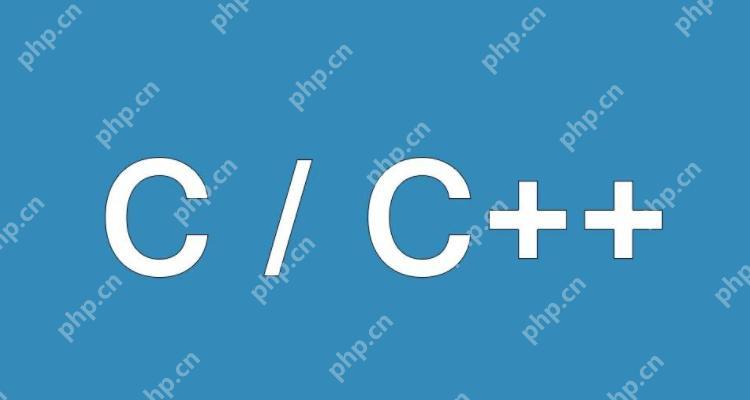How to understand RVO and NRVO in C?
RVO和NRVO是C++中的优化技术,分别用于优化临时对象和命名对象的返回值。1.RVO通过在调用者栈上直接构造临时对象,避免复制。2.NRVO则对命名对象进行类似优化,但条件更严格。使用这些优化需注意依赖性、调试难度和性能影响。

在C++的世界里,RVO(Return Value Optimization)和NRVO(Named Return Value Optimization)是两个经常被讨论却又容易让人迷惑的优化技术。它们就像是C++这门语言给我们的小惊喜,让我们的代码既高效又优雅。今天,我们就来深入探讨一下这两个优化技术的奥秘。
RVO和NRVO是什么?
RVO和NRVO都是编译器在处理返回值时使用的优化手段。RVO指的是当一个函数返回一个局部变量时,编译器会直接将这个变量构造在调用者的栈上,而不是在函数内部构造然后再复制到调用者的栈上。NRVO则是RVO的一个扩展,它允许编译器对有命名的返回值进行类似的优化。
让我们来看看一个简单的例子:
class MyClass {
public:
MyClass() { std::cout << "Constructing MyClass\n"; }
MyClass(const MyClass&) { std::cout << "Copying MyClass\n"; }
~MyClass() { std::cout << "Destructing MyClass\n"; }
};
MyClass foo() {
return MyClass(); // RVO可能发生
}
MyClass bar() {
MyClass obj;
return obj; // NRVO可能发生
}在这个例子中,foo函数可能会触发RVO,而bar函数可能会触发NRVO。让我们来详细分析一下这两个优化是如何工作的,以及它们在实际编程中的影响。
RVO的工作原理
RVO的核心思想是避免不必要的复制构造。当一个函数返回一个临时对象时,编译器可以选择直接在调用者的栈上构造这个对象,而不是先在函数内部构造,再通过复制构造函数复制到调用者的栈上。这样可以节省一次复制操作,提高性能。
然而,RVO并不是总能发生。编译器需要满足一定的条件才能应用RVO,比如返回值必须是一个临时对象,并且没有其他引用指向这个对象。否则,编译器可能无法进行优化。
NRVO的工作原理
NRVO则是RVO的进一步扩展,它允许编译器对有命名的返回值进行优化。在上面的bar函数中,obj是一个有命名的局部变量,编译器可以选择直接在调用者的栈上构造obj,然后在函数结束时直接返回这个对象,而不是先复制再返回。
NRVO的应用条件比RVO更加严格,因为编译器需要确保没有其他引用指向这个有命名的对象,并且这个对象在整个函数生命周期内没有被修改过。
优劣与踩坑点
RVO和NRVO在提高代码性能方面无疑是非常有用的,但它们也有一些需要注意的地方:
- 依赖性问题:由于RVO和NRVO是编译器优化,依赖这些优化来保证代码正确性可能会导致问题。因为不同的编译器对这些优化的支持程度不同,可能会导致代码在不同环境下的行为不一致。
- 调试难度:当RVO和NRVO发生时,调试器可能会显示一些意想不到的行为,因为对象的构造和析构可能发生在意料之外的地方。
- 性能影响:虽然RVO和NRVO可以减少复制操作,但它们并不是总是能带来显著的性能提升。有时候,编译器可能会选择其他优化手段,比如移动构造函数,从而达到更好的性能。
实际应用中的建议
在实际编程中,我们可以采取一些策略来更好地利用RVO和NRVO:
- 使用临时对象:尽量使用临时对象作为返回值,这样可以增加RVO发生的概率。
- 避免复杂的返回路径:尽量简化函数的返回路径,避免有多个返回语句指向同一个对象,这样可以增加NRVO发生的概率。
- 关注移动语义:在C++11及以后的标准中,移动构造函数可以替代复制构造函数,从而在某些情况下提供更好的性能。如果你的类支持移动语义,那么即使RVO和NRVO没有发生,性能仍然可以得到保证。
总结
RVO和NRVO是C++中非常有用的优化技术,它们可以显著提高代码的性能。然而,理解它们的原理和应用条件是非常重要的。在实际编程中,我们需要综合考虑这些优化技术的优劣,合理利用它们,同时也要做好备选方案,以应对不同的编译环境和调试需求。
The above is the detailed content of How to understand RVO and NRVO in C?. For more information, please follow other related articles on the PHP Chinese website!

Hot AI Tools

Undresser.AI Undress
AI-powered app for creating realistic nude photos

AI Clothes Remover
Online AI tool for removing clothes from photos.

Undress AI Tool
Undress images for free

Clothoff.io
AI clothes remover

Video Face Swap
Swap faces in any video effortlessly with our completely free AI face swap tool!

Hot Article

Hot Tools

Notepad++7.3.1
Easy-to-use and free code editor

SublimeText3 Chinese version
Chinese version, very easy to use

Zend Studio 13.0.1
Powerful PHP integrated development environment

Dreamweaver CS6
Visual web development tools

SublimeText3 Mac version
God-level code editing software (SublimeText3)

Hot Topics
 1655
1655
 14
14
 1414
1414
 52
52
 1307
1307
 25
25
 1254
1254
 29
29
 1228
1228
 24
24
 C# vs. C : History, Evolution, and Future Prospects
Apr 19, 2025 am 12:07 AM
C# vs. C : History, Evolution, and Future Prospects
Apr 19, 2025 am 12:07 AM
The history and evolution of C# and C are unique, and the future prospects are also different. 1.C was invented by BjarneStroustrup in 1983 to introduce object-oriented programming into the C language. Its evolution process includes multiple standardizations, such as C 11 introducing auto keywords and lambda expressions, C 20 introducing concepts and coroutines, and will focus on performance and system-level programming in the future. 2.C# was released by Microsoft in 2000. Combining the advantages of C and Java, its evolution focuses on simplicity and productivity. For example, C#2.0 introduced generics and C#5.0 introduced asynchronous programming, which will focus on developers' productivity and cloud computing in the future.
 Where to write code in vscode
Apr 15, 2025 pm 09:54 PM
Where to write code in vscode
Apr 15, 2025 pm 09:54 PM
Writing code in Visual Studio Code (VSCode) is simple and easy to use. Just install VSCode, create a project, select a language, create a file, write code, save and run it. The advantages of VSCode include cross-platform, free and open source, powerful features, rich extensions, and lightweight and fast.
 Golang and C : Concurrency vs. Raw Speed
Apr 21, 2025 am 12:16 AM
Golang and C : Concurrency vs. Raw Speed
Apr 21, 2025 am 12:16 AM
Golang is better than C in concurrency, while C is better than Golang in raw speed. 1) Golang achieves efficient concurrency through goroutine and channel, which is suitable for handling a large number of concurrent tasks. 2)C Through compiler optimization and standard library, it provides high performance close to hardware, suitable for applications that require extreme optimization.
 The Performance Race: Golang vs. C
Apr 16, 2025 am 12:07 AM
The Performance Race: Golang vs. C
Apr 16, 2025 am 12:07 AM
Golang and C each have their own advantages in performance competitions: 1) Golang is suitable for high concurrency and rapid development, and 2) C provides higher performance and fine-grained control. The selection should be based on project requirements and team technology stack.
 Golang and C : The Trade-offs in Performance
Apr 17, 2025 am 12:18 AM
Golang and C : The Trade-offs in Performance
Apr 17, 2025 am 12:18 AM
The performance differences between Golang and C are mainly reflected in memory management, compilation optimization and runtime efficiency. 1) Golang's garbage collection mechanism is convenient but may affect performance, 2) C's manual memory management and compiler optimization are more efficient in recursive computing.
 Python vs. C : Learning Curves and Ease of Use
Apr 19, 2025 am 12:20 AM
Python vs. C : Learning Curves and Ease of Use
Apr 19, 2025 am 12:20 AM
Python is easier to learn and use, while C is more powerful but complex. 1. Python syntax is concise and suitable for beginners. Dynamic typing and automatic memory management make it easy to use, but may cause runtime errors. 2.C provides low-level control and advanced features, suitable for high-performance applications, but has a high learning threshold and requires manual memory and type safety management.
 How to use VSCode
Apr 15, 2025 pm 11:21 PM
How to use VSCode
Apr 15, 2025 pm 11:21 PM
Visual Studio Code (VSCode) is a cross-platform, open source and free code editor developed by Microsoft. It is known for its lightweight, scalability and support for a wide range of programming languages. To install VSCode, please visit the official website to download and run the installer. When using VSCode, you can create new projects, edit code, debug code, navigate projects, expand VSCode, and manage settings. VSCode is available for Windows, macOS, and Linux, supports multiple programming languages and provides various extensions through Marketplace. Its advantages include lightweight, scalability, extensive language support, rich features and version
 How to execute code with vscode
Apr 15, 2025 pm 09:51 PM
How to execute code with vscode
Apr 15, 2025 pm 09:51 PM
Executing code in VS Code only takes six steps: 1. Open the project; 2. Create and write the code file; 3. Open the terminal; 4. Navigate to the project directory; 5. Execute the code with the appropriate commands; 6. View the output.




